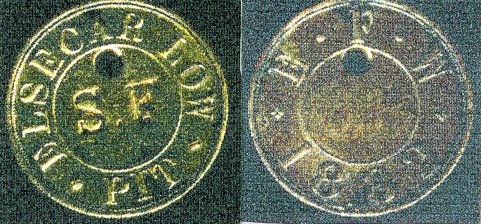
An Early Dated Colliery Check from Elsecar Low Pit.

Obverse & Reverse details of an Elsecar Low Pit Check.
Recently I acquired two brass embossed mining checks which I consider to be the best in my collection. The checks are from Elsecar Low Pit in Yorkshire and are double sided bearing the legend "E.F.W. 1882" on their reverse sides. The initials "EFW" no doubt stand for those of the pit's once owner Earl Fitzwilliam.
Being a checks from a pit local to me I decided to do a bit of research. I contacted a friend of mine George Beedan from Wombwell, a renowned mining historian. He gave me the following information.
Elsecar Low Colliery was also known locally as Hemingfield Colliery. It was situated about half a mile from Elsecar Main Colliery. The pit was sunk in 1840 and reached the Barnsley Bed Coal Seam at a depth of 117 yards.
The pit's first Manager was a Hemingfield man by the name of William Ford. As the pit was being sunk so was the house being built which was to become the managers residence. This house is still occupied today at Tingle Bridge, Hemingfield. From the main road the house's dedication stone can still be clearly seen. It bears bears the date "1840".
The colliery had a Cupola Furnace shaft for ventilation purposes plus a small diameter (8 foot) pumping shaft for raising water. This second shaft also allowed the pit to comply the inevitable law of escape which only came into effect after the Hester Hartley Pit disaster of 1862.
The coal winding shaft was known colloquially as the " Bicycle Wheel Pit " due to the fact that the two pulley wheels being mounted one on top of the other.
Sinking of the pit was complete in 1840 but little coal was drawn at first due to problems of ground water ingress. However, by 1846 coal was being won at 1000 tons per day. The mine was worked using the pillar and stall method with roadways being driven to the boundary of the royalty and then retreated back to the shafts.
At about one o'clock on the afternoon of 21st December 1852 a terrific explosion shook Elsecar Low Pit. At the time 130 men and boys were underground. The explosion of "fire damp" was later found to have been caused by certain of the colliers who had removed the tops off their safety lamps and who had been working by the increased light with resulted from the lamp's naked flame. Mercifully only five colliers died in the explosion.
Elsecar Low Pit closed in 1920 and its headgear removed in 1935. One of its shafts is still used as a mine water pump station.
The Elsecar Low Pit checks in my collection were from a small group of at least four recently discovered locally. The checks are seemingly unique in that they all bore hand stamped initials instead of the usual identification numbers in their obverse fields. Similarly the double sided embossed design of these checks plus the the enigmatic date of "1882" in their reverse legends is also unusual. As yet my researches have failed to find any significance to this date and one is only left to assume that 1882 was the year in which they were made.
The four separate examples of the Elsecar Low Pit checks which I referred to above bore the following sets of initials;
S.F.
B.K.
A.L.
J.T.
From an original colliery manpower ledger for Elsecar Low Pit I have been able to match the initials on my two examples of this pit check with the following named colliers;
A.L. - Albert Lomas, Collier, Feb. 1881.
J.T. - James Taylor, aged 14 years, Feb. 1881.
How satisfying it is to add such a personal touch of history to the checks in ones collection.
Reproduced from an article in NMMA Newsletter No.1, Summer 1996. © Frank Burgin.